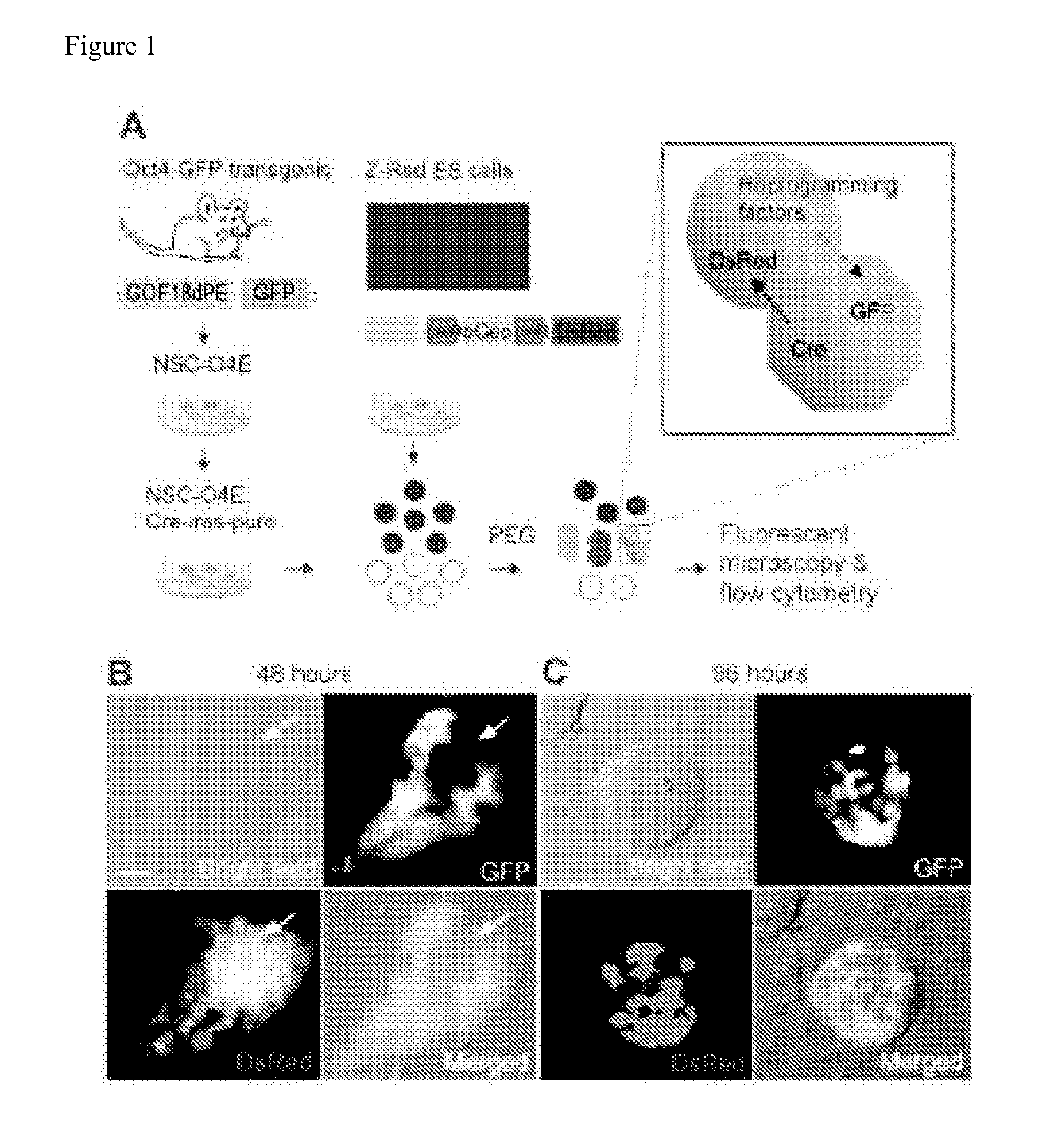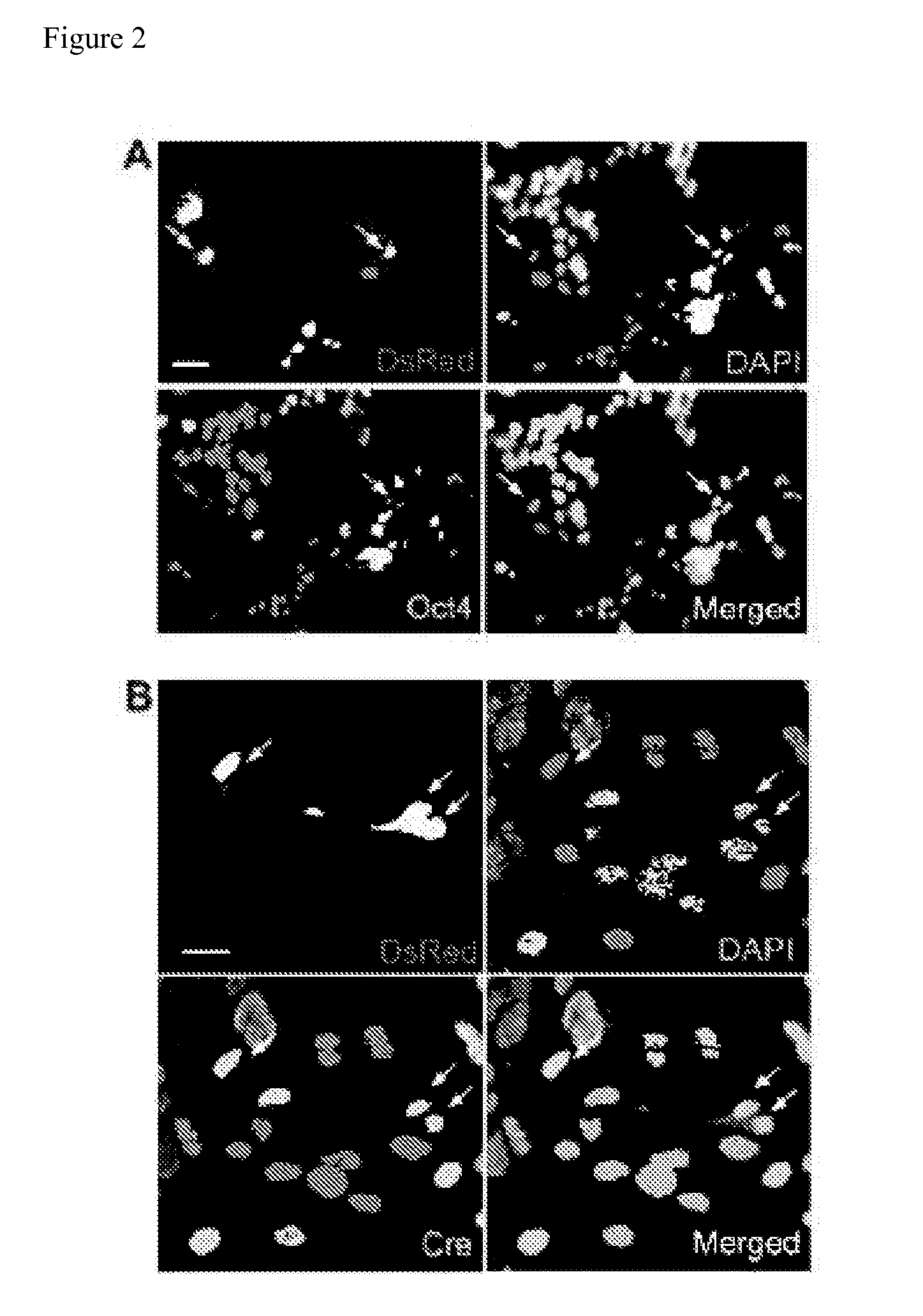Methods for promoting fusion and reprogramming of somatic cells
- Summary
- Abstract
- Description
- Claims
- Application Information
AI Technical Summary
Benefits of technology
Problems solved by technology
Method used
Image
Examples
example 1
Visualization of ESC Fusion-Induced Oct4 Reactivation in Adult NSCs with CLEAR
[0195]CLEAR strategy uses engineered ESCs and NSCs for monitoring fusion-induced DsRed expression and reprogramming-induced GFP expression (FIG. 1A). Z-Red ESCs were derived from a clonal ESC line containing one copy of a transgene (CAG-loxP-LacZ::neomycin-polyA-loxP-DsRed.T3) as a Cre recombination excision reporter [22]. Upon introduction of Cre activity, transfected cells exhibited strong red fluorescence resulting from the DsRed expression (FIG. 2A). This line of ESCs has been previously used to generate reporter mice and we confirmed that Z-Red ESC were capable of reprogramming somatic NSCs after fusion followed by long-term double drug selection (FIG. 3).
[0196]Adult NSCs were isolated from Oct4-GFP (GOF 18-A PE-EGFP) transgenic mice [19,23] and transduced by retroviruses to stably co-express Cre and the puromycin resistance gene through a bicistronic cassette (termed CIPOE NSCs hereafter). Somatic ce...
example 2
Characterization of ESC Fusion-Induced Reprogramming with CLEAR
[0198]To quantitatively analyze the reprogramming-induced Oct4-GFP re-activation, dual-color flow cytometry was used to display and measure the cell population that underwent PEG-induced cell fusion. Viable cells were identified by their typical FSC (Forward Scatter) and SSC (Side Scatter) properties. To ensure appropriate gating for GYP+ and DsRed+ events and to compensate the spectrum crossover of GFP and DsRed signals, the system was first calibrated using multiple control cells, including Z-Red ESCs, CIPOE NSCs, mixed Z-Red ESCs and CIPOE NSCs without PEG. Z-Red ESCs transfected with a constitutive Cre expression plasmid, and CIPOE NSCs transfected with a Cre excision reporter plasmid (FIG. 4A). The resulting gates allowed accurate quantification of DsRed+GFP+ cells and DsRed+GFP− cells, as shown in typical analytic dot plots (FIG. 4A).
[0199]ESC fusion-induced Oct4 re-activation from NSCs was quantitatively measured ...
example 3
Involvement of Chromatin Demethylation in ESC-Induced Oct4 Reactivation in Adult Somatic Stem Cells
[0200]To explore the underlying mechanism for reprogramming, the potential involvement of chromatin-modifying enzymes was assessed. A panel of pharmacological inhibitors of histone acetyltransferases, deacetylases, methyltransferases and demethylases was screened during the first 48 hours after fusion. Administration of inhibitors only during early time window after fusion ensures specific effects on reprogramming but not long-term non-specific effects on survival, proliferation and differentiation of hybrid cells. The results showed that the HDAC inhibitor Trichostatin A (TSA) as well as various other inhibitors were either ineffective, toxic to the cells, or led to mild deficit on reprogramming-induced Oct4 reactivation (see Table 1). Table 1, shown below, shows the effects of pharmacological inhibitors on reprogramming.
TABLE 1Concen-InhibitorsTargettrationEffectsTSAHDAC100 nM pro-di...
PUM
| Property | Measurement | Unit |
|---|---|---|
| Fluorescence | aaaaa | aaaaa |
Abstract
Description
Claims
Application Information
 Login to View More
Login to View More - R&D
- Intellectual Property
- Life Sciences
- Materials
- Tech Scout
- Unparalleled Data Quality
- Higher Quality Content
- 60% Fewer Hallucinations
Browse by: Latest US Patents, China's latest patents, Technical Efficacy Thesaurus, Application Domain, Technology Topic, Popular Technical Reports.
© 2025 PatSnap. All rights reserved.Legal|Privacy policy|Modern Slavery Act Transparency Statement|Sitemap|About US| Contact US: help@patsnap.com



